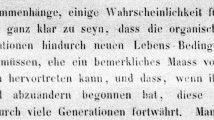Conclusions
While Wallace disagreed with Darwin that domesticates provided a great deal of useful information on wild populations,71 Darwin continued to draw on his domesticated animals and plants to inform him on the workings of his theory. Unlike Wallace, his exposure to natural populations was extremely limited after his return from the Beagle voyage. By the 1850s, he had settled into a life at Down House and was becoming more and more withdrawn from London scientific circles. He turned to his network of informants, visits from colleagues such as Hooker and T. H. Huxley, subscriptions to various journals, and his own experimental studies at Down.
This work on domesticates was clearly related to other natural history studies conducted by Darwin and others during the same period. For example, during the 1850s when Darwin worked on domesticates, he was also engaged in questions of geographic distribution. To study the dispersal and subsequent viability of introduced seeds, he soaked various seeds in a tub filled with seawater and counted which of the seeds floated after a given period; later he planted the seeds in the yard at Down to look for potential viability. There was no attempt at controlled, replicated experiments in these studies, or in his work with domesticates, nor should there have been. To Darwin the results of one experiment represented a potential truth of nature, and he was quick to seize upon these results as supporting evidence for his theory.
I have suggested in this paper that his work on domesticates was not simply meant to provide an analogy for natural selection but rather became a research program to investigate other aspects of his natural selection theory, especially inheritance and variability; these subjects were integral parts of his theory of natural selection, but by 1859 he had not found a mechanism to account for them. The experiments brought home the difficult problems of inheritance, and Darwin specifically formulated pangenesis to account for these problems. Pangenesis was not an afterthought but an integration of several decades of thinking on inheritance. It was a unified theory to explain the complicated results he witnessed in his own experiments.
Much of the Darwin scholarship has focused on Darwin's path toward the discovery of natural selection. Natural selection per se was a major interest, but not the only area of interest to Darwin. Inheritance was an area of serious concern for him both before and after he had formulated natural selection. His experimentation with domesticates was an attempt to look beyond natural selection and to concentrate on the difficult subject of inheritance. He found inheritance especially troublesome, requiring a “provisional hypothesis” to account for it. To see domesticates, as they are described in the Origin, as merely an analogy for natural selection, does not account for the importance Darwin placed on them. For him they were not man's monstrous productions, but worthy experimental subjects providing him with crucial information on inheritance.
Similar content being viewed by others
Author information
Authors and Affiliations
Rights and permissions
About this article
Cite this article
Bartley, M.M. Darwin and domestication: Studies on inheritance. J Hist Biol 25, 307–333 (1992). https://doi.org/10.1007/BF00162844
Issue Date:
DOI: https://doi.org/10.1007/BF00162844



